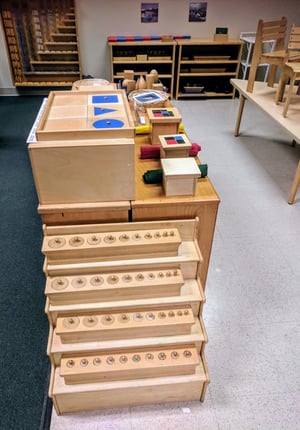
Education is certainly my calling. When choosing my path as a teacher, the Montessori philosophy captivated me more than most. It was peaceful, harmonious, respectful to the child, reflexive, and intentional.
Once in the field, I realized children were geniuses in their own right. They all had different talents and could blossom—as long as I, their teacher, followed and challenged their individuality.
I adored every moment I spent with children in my journey as a classroom teacher, learning from them and making sure they kept growing and developing with joy. Many years in the future, I sat in a CLASS training, and it all came together in a broader spectrum. It did not matter if it was Montessori or any other curriculum or approach. What every teacher had access to was fostering intentional and effective interactions of teachers with children and children with children.
In a Montessori classroom, children engage in the tasks of their choice. The observant teacher challenges them to the next physical, emotional, cognitive, or linguistic level. The ultimate goal is to incentivize children to become wholesome, responsible citizens.
As Maria Montessori said,
Times have changed, and science has made great progress, and so has our work; but our principles have only been confirmed, and along with them our conviction that mankind can hope for a solution to its problems, among which the most urgent are those of peace and unity, only by turning its attention and energies to the discovery of the child and to the development of the great potentialities of the human personality in the course of its formation. xi)
From my point of view, CLASS and Montessori’s method are related on every domain, and I firmly believe that she would have endorsed and adopted CLASS in her practice.
Emotional Support
This domain focuses on positive and respectful social-emotional relationships. It considers the teacher’s awareness and responses to students’ needs and their levels of comfort as well as the regard and support of the teacher for the students’ interest, independence, autonomy, and leadership. The indicators of every dimension of CLASS can also describe the Montessori classroom. In showing Teacher Sensitivity, the Montessori teacher scans the room even when she is working with an individual child or a group of children, ensuring that they are all joyfully—and safely—engaged in a task.. When detecting a need for immediate attention, she respectfully excuses herself to respond to the identified need and then returns to the previous commitment. Regard for Student Perspectives is high when—during Montessori time—children choose their task independently, according to their interest and level of development, and when finished, return it to its place in an orderly fashion. When children have worked together, setting up and cleaning up are collaborative efforts.
Classroom Organization
As you walk in a Montessori environment, you are instantly met with children regulating their own behavior. They and the teacher have worked on learning to control their thoughts and their actions to meet the expectations of the classroom. The students help each other regulate when necessary, indicating responsibility for their own environment and camaraderie. To ensure Productivity, the teacher has worked hard prior to the children arriving to prepare the environment with the needed materials, based on not only their preferences but also their level of progress, ensuring challenges to next levels of learning and reinforcement of what they have worked on previously. This keeps children occupied with a plethora of choices when moving from one job to another.
behavior. They and the teacher have worked on learning to control their thoughts and their actions to meet the expectations of the classroom. The students help each other regulate when necessary, indicating responsibility for their own environment and camaraderie. To ensure Productivity, the teacher has worked hard prior to the children arriving to prepare the environment with the needed materials, based on not only their preferences but also their level of progress, ensuring challenges to next levels of learning and reinforcement of what they have worked on previously. This keeps children occupied with a plethora of choices when moving from one job to another.
You’ll also see high Instructional Learning Formats in the way the Montessori materials involve all the senses. They encourage children to match by sound, weight, or smell. They exercise the eyes and small muscles for prewriting, introduce mathematical operations such as multiplication and division, and offer plenty of musical and literacy experiences. The materials are chosen so that students are engaged and learning opportunities are maximized.
Instructional Support
As children have learned to express and deal with personal feelings, they have learned to empathize with others. They have developed responsibility for the upkeep of their own environment. The mind and the body have been set up for the development of cognition and language.
In a Montessori environment, children face questions such as “Why does the upside-down pyramid fall?” and opportunities for problem-solving through prompts such as “How can we set it up so that it stays standing?” Similar to what CLASS observers look for in Quality of Feedback, most of the Montessori materials are built with error control, giving children hints, but the Montessori Teacher also scaffolds the learning by asking the children appropriate questions for them to arrive at the correct answer. Children build higher-order thinking skills (Concept Development) when they are working in geography by not only placing the pieces of a puzzle of countries where they belong but also matching them with their flags and capitals, and then getting deeper into research about their climate, flora, fauna, language, culture, similarities, and much more. This allows for integrating previous knowledge, investigating for new information, and relating it to personal experiences.

In a traditional Montessori classroom, the opportunity for spoken language varies by the activity. Some presentations are completely nonverbal, based merely in observation, while others entail endless back-and-forth exchanges. A typical example could be working on the Farm task, naming animals by age and role (foal-mare-colt, piglet-sow-boar), expanding on the food they eat and their natural habitat, wondering in conversations about whether hogs or horses live in the house, why or why not, what would happen if so? Children in Montessori Environments can experience high-level Language Modeling or rich language opportunities throughout the day, as well as moments for reflection and internalization of new concepts or a new language.
Montessori, M. (1948). The Discovery of the Child. New York, NY: The Ballantine Publishing Group.
Want to learn more? Listen to the CLASS and Montessori episode of Teaching with CLASS.